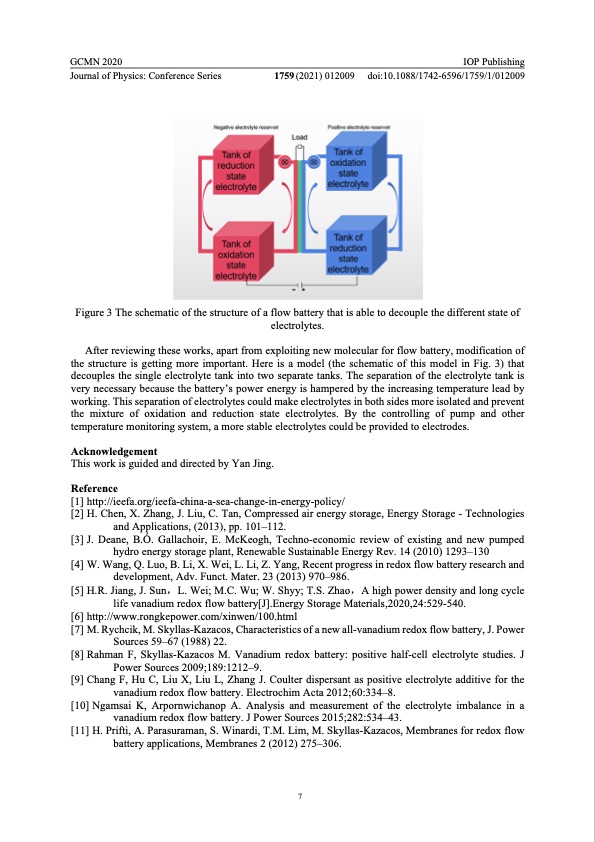
PDF Publication Title:
Text from PDF Page: 008
GCMN 2020 IOP Publishing Journal of Physics: Conference Series 1759 (2021) 012009 doi:10.1088/1742-6596/1759/1/012009 Figure 3 The schematic of the structure of a flow battery that is able to decouple the different state of electrolytes. After reviewing these works, apart from exploiting new molecular for flow battery, modification of the structure is getting more important. Here is a model (the schematic of this model in Fig. 3) that decouples the single electrolyte tank into two separate tanks. The separation of the electrolyte tank is very necessary because the battery’s power energy is hampered by the increasing temperature lead by working. This separation of electrolytes could make electrolytes in both sides more isolated and prevent the mixture of oxidation and reduction state electrolytes. By the controlling of pump and other temperature monitoring system, a more stable electrolytes could be provided to electrodes. Acknowledgement This work is guided and directed by Yan Jing. Reference [1] http://ieefa.org/ieefa-china-a-sea-change-in-energy-policy/ [2] H. Chen, X. Zhang, J. Liu, C. Tan, Compressed air energy storage, Energy Storage - Technologies and Applications, (2013), pp. 101–112. [3] J. Deane, B.Ó. Gallachoir, E. McKeogh, Techno-economic review of existing and new pumped hydro energy storage plant, Renewable Sustainable Energy Rev. 14 (2010) 1293–130 [4] W. Wang, Q. Luo, B. Li, X. Wei, L. Li, Z. Yang, Recent progress in redox flow battery research and development, Adv. Funct. Mater. 23 (2013) 970–986. [5] H.R. Jiang, J. Sun,L. Wei; M.C. Wu; W. Shyy; T.S. Zhao,A high power density and long cycle life vanadium redox flow battery[J].Energy Storage Materials,2020,24:529-540. [6] http://www.rongkepower.com/xinwen/100.html [7] M. Rychcik, M. Skyllas-Kazacos, Characteristics of a new all-vanadium redox flow battery, J. Power Sources 59–67 (1988) 22. [8] Rahman F, Skyllas-Kazacos M. Vanadium redox battery: positive half-cell electrolyte studies. J Power Sources 2009;189:1212–9. [9] Chang F, Hu C, Liu X, Liu L, Zhang J. Coulter dispersant as positive electrolyte additive for the vanadium redox flow battery. Electrochim Acta 2012;60:334–8. [10] Ngamsai K, Arpornwichanop A. Analysis and measurement of the electrolyte imbalance in a vanadium redox flow battery. J Power Sources 2015;282:534–43. [11] H. Prifti, A. Parasuraman, S. Winardi, T.M. Lim, M. Skyllas-Kazacos, Membranes for redox flow battery applications, Membranes 2 (2012) 275–306. 7PDF Image | Emerging Aqueous Flow Batteries and Perspectives

PDF Search Title:
Emerging Aqueous Flow Batteries and PerspectivesOriginal File Name Searched:
Zhang_2021_J_Phys_Conf_Ser_1759_012009.pdfDIY PDF Search: Google It | Yahoo | Bing
Salgenx Redox Flow Battery Technology: Salt water flow battery technology with low cost and great energy density that can be used for power storage and thermal storage. Let us de-risk your production using our license. Our aqueous flow battery is less cost than Tesla Megapack and available faster. Redox flow battery. No membrane needed like with Vanadium, or Bromine. Salgenx flow battery
| CONTACT TEL: 608-238-6001 Email: greg@salgenx.com | RSS | AMP |